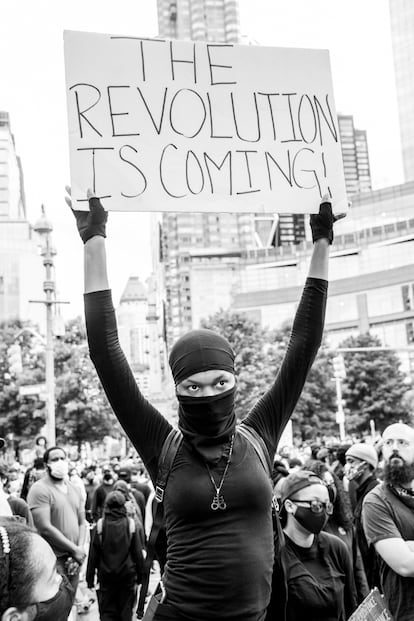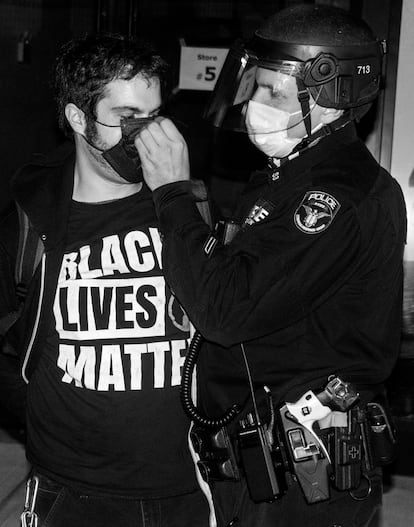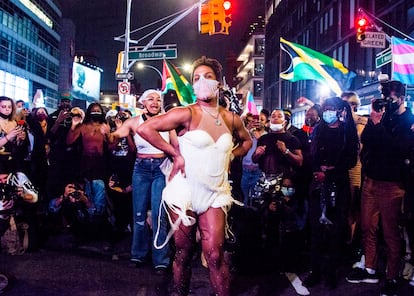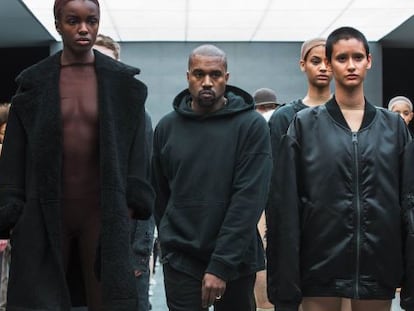When the #blacklivesmatter movement took over New York
A new book of photography chronicles the rage that consumed the Big Apple after George Floyd’s murder by Minneapolis police

In July 2013, George Zimmerman was acquitted of second-degree murder by a US court after fatally shooting an African-American teenager named Trayvon Martin. Even though no weapons were found at the crime scene, a jury decided that Zimmerman had acted in self-defense. The acquittal ignited an enormous backlash in the African-American community and popularized the #blacklivesmatter hashtag on social media. Months later, after the death of two more African Americans in clashes with police in New York and Ferguson (near St. Louis, Missouri), the hashtag transformed into a broad protest of police violence against the African American community. When George Floyd died at the hands of Minneapolis police officers in the spring of 2020, the Black Lives Matter (BLM) movement exploded worldwide.

New York City Rising: Protests, Rallies, & Police Riots, 2020-2021 (Hat & Beard Press) is a collection of photographs by Ruvan Wijesooriya taken during the police riots and protests surrounding the murder of George Floyd and the Black Lives Matter movement. The son of Sri Lankan immigrants first learned about civil rights from his parents’ struggles when they came to the US in 1972. Wijesooriya said, “I called a national magazine and convinced them to let me cover the protests. But I didn’t expect so many police departments to respond by violating constitutional rights, breaking laws and assaulting people – and then lying about it. They arrested as many protesters as possible and crowded them all together. It was early in the pandemic, and everyone feared getting sick. The magazine didn’t want to publish the photos, but some were later used as evidence in many cases against New York police officers for brutality,” said Wijesooriya. “I think the movement grew so quickly because of the extreme violence used by police to suppress those protests. To be honest, I had some faith in the police before the first BLM demonstrations. But not after that.”

Kiara Williams founded “Warriors In The Garden,” a group advocating for the non-violent defense of African-American rights. One of the best-known faces in the constellation of organizations under the Black Lives Matter umbrella, Williams said, “I remember the murders of Ahmaud Arbery, Breonna Taylor and George Floyd. It was all over social media for the whole world to see. That’s why I went to the first demonstration. Hundreds of protestors faced a building protected by metal fences and a huge police contingent. Someone threw an empty water bottle, and suddenly the police started discharging pepper spray as they violently charged the crowd. When I got home, I was furious. Experiencing that brutality gave me the strength to go out again the next day.”

Wijesooriya believes BLM has transcended the protests that characterized its early days. “I think the movement has moved from street activism to something more focused on culture. At the same time, social media has given the African-American community a voice that journalism never provided. That has led to other media outlets hiring more African-Americans and giving them positions of authority. It’s a cultural shift fueled by the aggressiveness of conservatives and the right wing.”
Others are not so optimistic. Gary Dean Clarke, a Jamaican photographer based in New York who also chronicled the early days of BLM in the city, believes that things won’t change despite everything. “It’s human nature to forget over time and go back to old habits, back to work and their own lives. BLM has been placed on the back burner… until someone else is killed.”
Sign up for our weekly newsletter to get more English-language news coverage from EL PAÍS USA Edition
Tu suscripción se está usando en otro dispositivo
¿Quieres añadir otro usuario a tu suscripción?
Si continúas leyendo en este dispositivo, no se podrá leer en el otro.
FlechaTu suscripción se está usando en otro dispositivo y solo puedes acceder a EL PAÍS desde un dispositivo a la vez.
Si quieres compartir tu cuenta, cambia tu suscripción a la modalidad Premium, así podrás añadir otro usuario. Cada uno accederá con su propia cuenta de email, lo que os permitirá personalizar vuestra experiencia en EL PAÍS.
¿Tienes una suscripción de empresa? Accede aquí para contratar más cuentas.
En el caso de no saber quién está usando tu cuenta, te recomendamos cambiar tu contraseña aquí.
Si decides continuar compartiendo tu cuenta, este mensaje se mostrará en tu dispositivo y en el de la otra persona que está usando tu cuenta de forma indefinida, afectando a tu experiencia de lectura. Puedes consultar aquí los términos y condiciones de la suscripción digital.
More information
Archived In
Últimas noticias
Welcome to the post-religion era: The idea of Christianity as the absolute truth has become obsolete
‘I thought you would like it’: The risky sexual practice popularized by TV shows and TikTok
The digitalization of tourism: ‘They promise experiences and gave us the worst possible one’
Mexican peso defies uncertainty with forecasts of a new period of stability in 2026
Most viewed
- Sinaloa Cartel war is taking its toll on Los Chapitos
- Reinhard Genzel, Nobel laureate in physics: ‘One-minute videos will never give you the truth’
- Oona Chaplin: ‘I told James Cameron that I was living in a treehouse and starting a permaculture project with a friend’
- Why the price of coffee has skyrocketed: from Brazilian plantations to specialty coffee houses
- Silver prices are going crazy: This is what’s fueling the rally











































